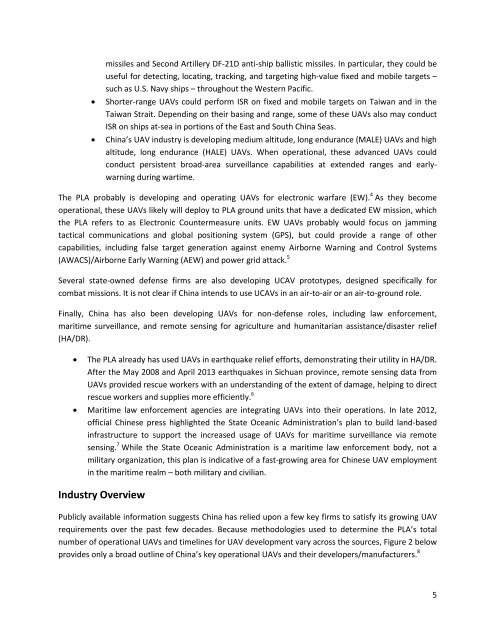China's Military UAV Industry_14 June 2013
Create successful ePaper yourself
Turn your PDF publications into a flip-book with our unique Google optimized e-Paper software.
missiles and Second Artillery DF-21D anti-ship ballistic missiles. In particular, they could be<br />
useful for detecting, locating, tracking, and targeting high-value fixed and mobile targets –<br />
such as U.S. Navy ships – throughout the Western Pacific.<br />
Shorter-range <strong>UAV</strong>s could perform ISR on fixed and mobile targets on Taiwan and in the<br />
Taiwan Strait. Depending on their basing and range, some of these <strong>UAV</strong>s also may conduct<br />
ISR on ships at-sea in portions of the East and South China Seas.<br />
China’s <strong>UAV</strong> industry is developing medium altitude, long endurance (MALE) <strong>UAV</strong>s and high<br />
altitude, long endurance (HALE) <strong>UAV</strong>s. When operational, these advanced <strong>UAV</strong>s could<br />
conduct persistent broad-area surveillance capabilities at extended ranges and earlywarning<br />
during wartime.<br />
The PLA probably is developing and operating <strong>UAV</strong>s for electronic warfare (EW). 4 As they become<br />
operational, these <strong>UAV</strong>s likely will deploy to PLA ground units that have a dedicated EW mission, which<br />
the PLA refers to as Electronic Countermeasure units. EW <strong>UAV</strong>s probably would focus on jamming<br />
tactical communications and global positioning system (GPS), but could provide a range of other<br />
capabilities, including false target generation against enemy Airborne Warning and Control Systems<br />
(AWACS)/Airborne Early Warning (AEW) and power grid attack. 5<br />
Several state-owned defense firms are also developing UCAV prototypes, designed specifically for<br />
combat missions. It is not clear if China intends to use UCAVs in an air-to-air or an air-to-ground role.<br />
Finally, China has also been developing <strong>UAV</strong>s for non-defense roles, including law enforcement,<br />
maritime surveillance, and remote sensing for agriculture and humanitarian assistance/disaster relief<br />
(HA/DR).<br />
<br />
The PLA already has used <strong>UAV</strong>s in earthquake relief efforts, demonstrating their utility in HA/DR.<br />
After the May 2008 and April <strong>2013</strong> earthquakes in Sichuan province, remote sensing data from<br />
<strong>UAV</strong>s provided rescue workers with an understanding of the extent of damage, helping to direct<br />
rescue workers and supplies more efficiently. 6<br />
Maritime law enforcement agencies are integrating <strong>UAV</strong>s into their operations. In late 2012,<br />
official Chinese press highlighted the State Oceanic Administration’s plan to build land-based<br />
infrastructure to support the increased usage of <strong>UAV</strong>s for maritime surveillance via remote<br />
sensing. 7 While the State Oceanic Administration is a maritime law enforcement body, not a<br />
military organization, this plan is indicative of a fast-growing area for Chinese <strong>UAV</strong> employment<br />
in the maritime realm – both military and civilian.<br />
<strong>Industry</strong> Overview<br />
Publicly available information suggests China has relied upon a few key firms to satisfy its growing <strong>UAV</strong><br />
requirements over the past few decades. Because methodologies used to determine the PLA’s total<br />
number of operational <strong>UAV</strong>s and timelines for <strong>UAV</strong> development vary across the sources, Figure 2 below<br />
provides only a broad outline of China’s key operational <strong>UAV</strong>s and their developers/manufacturers. 8<br />
5

















